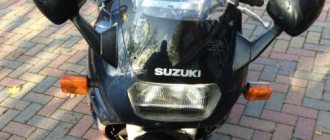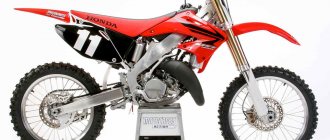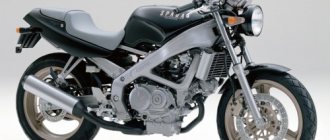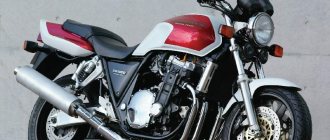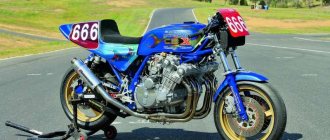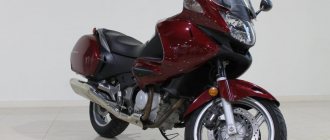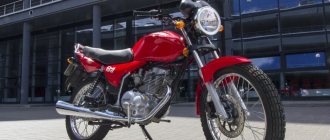| Honda CX500TC Turbo (1981-1982) |
Honda CX500 Turbo sports tourer model
was officially introduced in 1981 (1982 model year) primarily for the North American and West German export markets. The model was built on the basic version of the Honda CX500, but featured advanced front wind protection, electronic fuel injection and a turbine. The Honda CX500 Turbo was the first production Honda motorcycle with programmable fuel injection and a turbocharger, the use of which increased the maximum power from 50 to 82 hp compared to the basic version.
Another important feature of the Honda CX500 Turbo, as well as the entire CX500 line, was a 2-cylinder V-shaped liquid-cooled engine, located longitudinally in the frame (as on Moto Guzzi motorcycles), with a cylinder camber angle of 80°. It is also noteworthy that at first the longitudinally located V-shaped (90°) engine, when tested by pilots, turned out to be extremely uncomfortable ergonomically (the legs rested on the carburetors) - to solve this problem, the engineers had to reduce the cylinder camber to 80° and turn the cylinder heads to 22° relative to the cylinder axis. The engine is equipped with 4 valves per cylinder and a lower camshaft. Also, unlike the basic version, the Honda CX500 Turbo model received a reinforced clutch and gearbox.
Other features of the Honda CX500 Turbo include a steel frame, pneumatically adjustable suspension (the front fork has an anti-dive system TRAC - Torque Reactive Anti-dive Control), disc brakes, a 20-liter fuel tank, a 5-speed gearbox and a 260 kg curb weight.
1982 was the last year of production of the Honda CX500 Turbo, after which it was replaced by the new Honda CX650 Turbo, which, however, also lasted only one year.
Turbocharged motorcycle models from other Japanese manufacturers:
- Kawasaki GPZ750 Turbo / Kawasaki H2
- Suzuki XN85 Turbo
- Yamaha XJ650 Turbo
Specifications
Technical characteristics of Honda CX500 Turbo:
| Model | Honda CX500 Turbo |
| Motorcycle type | sports-tourist |
| Year of issue | 1981 (1982) |
| Frame | steel diagonal |
| engine's type | 2-cylinder, 4-stroke, V-shaped (80°) longitudinal, turbocharged |
| Working volume | 496 cm³ |
| Bore/Stroke | 78.0 x 52.0 mm |
| Compression ratio | 7.2:1 |
| Cooling | liquid |
| Number of valves per cylinder | OHV, 4 valves per cylinder |
| Fuel supply system | injector |
| Ignition type | transistor |
| Maximum power | 82.0 hp (60.3 kW) at 8000 rpm |
| Maximum torque | 79.0 Nm (8.1 kg*m) at 5000 rpm |
| Clutch | Multi-disc in oil bath, cable drive |
| Transmission | 5-speed |
| type of drive | cardan |
| Front tire size | 3.50H 18-4PR |
| Rear tire size | 120/90-V17 (64H) |
| Front brakes | 2 discs, 276 mm, 2-piston calipers |
| Rear brakes | 1 disc, 276 mm, 1-piston caliper |
| Front suspension | 37mm air fork with anti-dive (TRAC) and preload adjustment, 130mm travel |
| Rear suspension | Pendulum Pro-Link with pneumatic monoshock absorber (adjustable preload and rebound), stroke - 105 mm |
| Motorcycle length | 2260 mm |
| Motorcycle width | 720 mm |
| Motorcycle height | 1345 mm |
| Wheelbase | 1495 mm |
| Seat height | 790 mm |
| Minimum ground clearance (clearance) | 150 mm |
| Acceleration 0-100 km/h (0-60 mph) | 4.9 sec[1] |
| Maximum speed | 200 km/h[2] |
| Gas tank capacity | 20.0 l |
| Motorcycle weight (curb) | 260 kg |
MY MOTORCYCLE
The Honda CX500 is an almost unique motorcycle, primarily because it was equipped with a turbine as standard. Yes, yes, this is a turbocharged racing bike. This bike with a longitudinal V-twin with a volume of 497 cubic centimeters has a 4.5-centimeter turbine capable of spinning up to two hundred thousand revolutions per minute. The Nonda CX500 TC was first released in 1982. Motorcycles with turbines were then being developed by all Japanese motorcycle manufacturers - Yamaha, Kawasaki, Suzuki, but Honda managed to release the CX500 to the market first. The motorcycle turned out, of course, ambiguous. In addition, the above companies installed turbines on in-line engines, while Honda used a V-twin.
The result of turbocharging was high power in the upper rev range, and the 500cc CX500 rode on par with larger sportbikes. But due to the same turbine in the lower range, the engine produced quite little power and torque, and was also characterized by “jerky” and uneven operation.
Unfortunately, the Honda CX500 was not very popular. First of all, this was due to the considerable price that had to be paid for such an unusual motorcycle, but at the same time, sportbikes with 750 cc engines (750 cc - a very common cubic capacity for Japanese motorcycles of the 80s) rode no worse, and cost significantly cheaper.
In addition, the operation of the turbine on the CX500 caused certain complaints. By its design, the turbocharging was not bad, but the turbine took some time to “spin up”, and therefore the response to turning the throttle was slightly slow. To put it simply, first the motorcycle pilot unscrewed the handle, then for half a second nothing happened, after which he seemed to get a kick from behind, and the bike shot forward.
Due to this feature and obvious focus on track driving, the turbocharged Honda did not gain significant popularity and soon left the scene, losing the battle to conventional naturally aspirated engines. But to this day there are many fans who actively scour auctions and look for a CX500 in good condition. This is not a trivial task, given the age of the motorcycle, but due to its unusual nature, this model is popular among customizers, in particular among fans of cafe racer-style motorcycles.
Chassis
Early versions had a conventional suspension consisting of telescopic front forks with hydraulic damping and dual shock absorbers at the rear. Later versions had air-assisted forks and a Honda Pro-Link monoshock. American bikes (except GL500I, GL650I and Turbo) were equipped with a single front disc brake, while all other bikes have dual front disc brakes. Besides the vanilla CX500B, post-1980 models feature dual-piston calipers, replacing the single-piston calipers of earlier models. On Turbo and Eurosport models, the rear drum was replaced with a two-piston caliper and disc. All models have tubular steel frames with a large backbone, and the engine is used as a stressed member. Dual shock models use a mono-tube frame, while later Pro-Link models use a three-tube frame.
“Simply” Honda CX500 from the MichuMoto workshop
In nature, colorful messages are widespread. They show how living beings interact on our planet. Whether you want to attract an ally, protect yourself, or spread your DNA, it is the use of colors that will indicate whether your intention is successful or not. And, of course, the combination of red and black means one thing in this case - danger. So, out of courage, or out of stupidity, we dare to tell you the story of the creation of the custom “Simply” Honda CX500 from the Polish workshop MichuMoto.
“My name is Michal, and my personal garage is called MichuMoto,” says the workshop owner. “But when I say garage, I mean something like a small building in the backyard. In general, this is my home. I'm 39 years old and have a lot of experience working with motorcycles. A few years ago I started doing custom builds, but I never finish it due to family reasons. But then, a year ago, a Honda CX500 showed up in my little garage and the work started.” Initially, I wanted to create a bike without unnecessary parts and hide all the wiring to give the machine the cleanest look possible. Michal chose the colors at the very beginning of the project: he and his girlfriend simply became obsessed with them. Also, initially the motorcycle was intended for her, but while considering the implementation of the project, Michal suddenly came to the conclusion that the bike would be for himself. “We also planned to put a single saddle on it, identical tires front and rear, and it was going to be a hand-built bike, not a machine-made one. We had to make as many parts as our grinding, lathe and welding machines would allow us to do.”
Since Mike doesn't work on bikes full time, all the work had to be done in the evenings and on weekends. To put it simply, the guy was obsessed. “I had no idea how much work would go into this project. We started it a year ago and planned to finish it within this year. In the end the bike was finished in 13 months, so we weren't too late." “I bought a Yamaha SR500 gas tank that we cut in half to expand it. We moved the gas tank cap to the center, and installed the speedometer in the front part. This was the most difficult stage of the work. We spent 3 months on it.”
“The challenge was hiding the throttle wires in the handlebars. To do this, we made a mechanism that is hidden under a leather handle. Then all the bolts on the bike were covered with black paint. Our goal was not to buy as many expensive spare parts as possible and install them on a custom one. Instead, we wanted to make as many parts ourselves as possible.”
As a result, the MichuMoto workshop produced a bicycle-style handlebar, an SR500-style gas tank, upper and lower clamps, footpegs, a rear end, a brake pedal, a gear lever, a battery box and an original internal throttle mechanism.
The custom also features HEL brake pads in two colors, a headlight, tires, a few small parts from Wwag in Germany, front indicators from FrenchMonkeys, custom Hagon shocks from the UK and a saddle and grips from Lucky.
“The custom was inspired by the amazing CX500 from Kingston Customs. It has cool shapes and is definitely not your typical cafe racer. The handlebar of the bike is inspired by the old Russian motorcycle "Ukraine". In general, I tried to look for very minimalist parts, and in the end the bike took on a retro look. And I also tried to make the bike as symmetrical as possible.” So in the end, Mike wouldn't say that the bike was inspired by any specific object. Most of all, its final appearance was influenced by the original intention of the creator: least of all, to respect symmetry and lots and lots of black.
“What I like most about the finished bike is its simplicity. It really does have a very clean look. I very often hear the phrase: “I don’t know anything about motorcycles, but I would definitely like to have one.” I think we did everything right. It's hard to say what I like most about the bike. But I'm more likely to choose a handlebar that has a hand-made internal throttle mechanism and stitched grip pads."
“I didn’t have a chance to ride it properly because it’s winter in Poland now. But going to Prost is a very special experience for me, probably because this is the first project that I did entirely myself. No, this is not a high-speed monster. But you will enjoy every minute spent on it and will remain completely happy. I smile all the time. It has everything you need and nothing more. Driving it is fun, not stressful. And the width of the custom handlebars makes you feel like you’re riding a bike straight out of the 1940s.” We think it all sounds impressively great.
Honda CX500 Review
The Honda CX500 is an almost unique motorcycle, primarily because it was equipped with a turbine as standard. Yes, yes, this is a turbocharged racing bike. This bike with a longitudinal V-twin with a volume of 497 cubic centimeters has a 4.5-centimeter turbine capable of spinning up to two hundred thousand revolutions per minute.
The Nonda CX500 TC was first released in 1982. Motorcycles with turbines were then being developed by all Japanese motorcycle manufacturers - Yamaha, Kawasaki, Suzuki, but Honda managed to release the CX500 to the market first. The motorcycle turned out, of course, ambiguous. In addition, the above companies installed turbines on in-line engines, while Honda used a V-twin.
The result of turbocharging was high power in the upper rev range, and the 500cc CX500 rode on par with larger sportbikes. But due to the same turbine in the lower range, the engine produced quite little power and torque, and was also characterized by “jerky” and uneven operation.
Unfortunately, the Honda CX500 was not very popular. First of all, this was due to the considerable price that had to be paid for such an unusual motorcycle, but at the same time, sportbikes with 750 cc engines (750cc - a very common cubic capacity for Japanese motorcycles of the 80s) rode no worse, and were much cheaper .
In addition, the operation of the turbine on the CX500 caused certain complaints. By its design, the turbocharging was not bad, but the turbine took some time to “spin up”, and therefore the response to turning the throttle was slightly slow. To put it simply, first the motorcycle pilot unscrewed the handle, then for half a second nothing happened, after which he seemed to get a kick from behind, and the bike shot forward.
Due to this feature and obvious focus on track driving, the turbocharged Honda did not gain significant popularity and soon left the scene, losing the battle to conventional naturally aspirated engines. But to this day there are many fans who actively scour auctions and look for a CX500 in good condition. This is not a trivial task, given the age of the motorcycle, but due to its unusual nature, this model is popular among customizers, in particular among fans of “cafe racer” style motorcycles.
